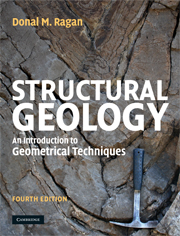Book contents
- Frontmatter
- Contents
- Preface
- Acknowledgements
- 1 Structural planes
- 2 Thickness and depth
- 3 Lines and intersecting planes
- 4 Planes and topography
- 5 Stereographic projection
- 6 Rotations
- 7 Vectors
- 8 Faults
- 9 Stress
- 10 Faulting
- 11 Deformation
- 12 Strain
- 13 Flow
- 14 Folds
- 15 Parallel folds
- 16 Similar folds
- 17 Folds and topography
- 18 Structural analysis
- 19 Tectonites
- 20 Drill hole data
- 21 Maps and cross sections
- 22 Block diagrams
- Appendices
- References
- Index
17 - Folds and topography
Published online by Cambridge University Press: 05 June 2012
- Frontmatter
- Contents
- Preface
- Acknowledgements
- 1 Structural planes
- 2 Thickness and depth
- 3 Lines and intersecting planes
- 4 Planes and topography
- 5 Stereographic projection
- 6 Rotations
- 7 Vectors
- 8 Faults
- 9 Stress
- 10 Faulting
- 11 Deformation
- 12 Strain
- 13 Flow
- 14 Folds
- 15 Parallel folds
- 16 Similar folds
- 17 Folds and topography
- 18 Structural analysis
- 19 Tectonites
- 20 Drill hole data
- 21 Maps and cross sections
- 22 Block diagrams
- Appendices
- References
- Index
Summary
Map symbols
Just as structural planes intersect the earth's surface to give characteristic outcrop patterns, equally distinctive though more complex patterns result from the intersection of folds with the topographic surface. In this chapter we treat some important aspects of the patterns made by folds which are essentially cylindrical.
If exposures are good, it is generally possible to locate and measure the attitudes of both the hinge and hinge surface of a fold in the field. On the other hand, if these features can not be directly observed, then the attitude information and the location of the hinge surface must be found using indirect methods.
In any case, the fold is then identified on the map with a line marking the trace of the hinge surface at the earth's surface, together with symbols indicating the attitude of the hinge and hinge surface and the direction of closure (Fig. 17.1).
Outcrop patterns
Horizontal folds have the simplest type of outcrop pattern. On a horizontal exposure plane, the map pattern of such a fold is essentially the sum of the patterns of the inclined limbs, that is, a series of parallel outcrop bands (Fig. 17.2a). If the relative age or correlation of the units, or the attitude at several points is not known, it may not be possible to interpret the pattern as being part of a fold at all.
- Type
- Chapter
- Information
- Structural GeologyAn Introduction to Geometrical Techniques, pp. 454 - 467Publisher: Cambridge University PressPrint publication year: 2009



